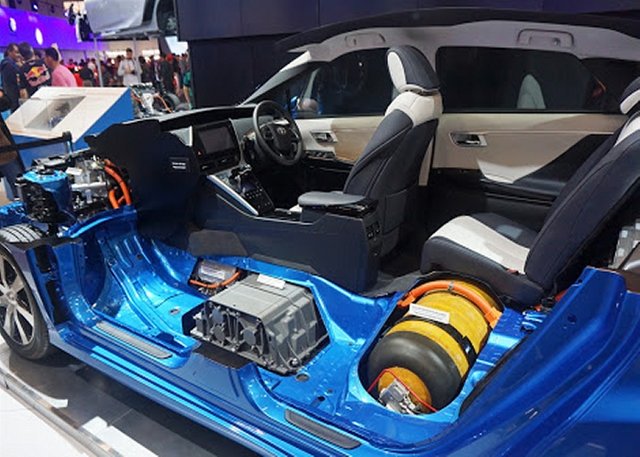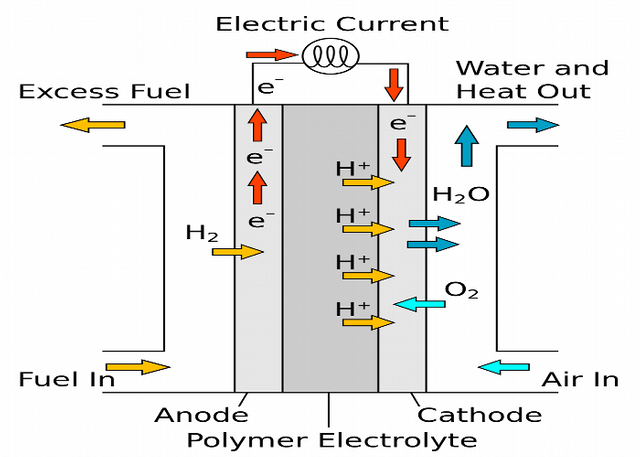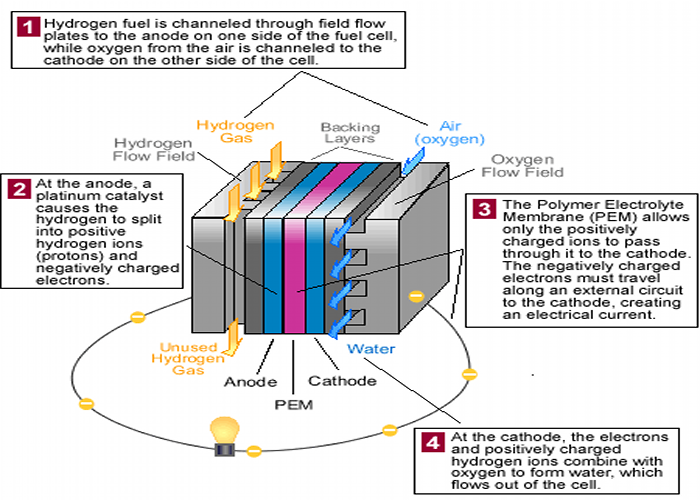Fuel Cell: Running Our Cars From Hydrogen And Water (Does It Worth The Trouble?)
You will agree with me that the number of gasoline and diesel based vehicles and machineries have increased tremendously worldwide within a century. A century ago, the total number of vehicles might have been in thousands but not anymore. Today, the number of vehicles globally may have gotten to a billion. This means that one person out of every seven persons you see owns a car! Let's assume the earth is one giant gas station with finite supply of fuel and you will appreciate that we have a big problem.
1.jpg)
[A Toyota Mirai full cell cutaway. Source: Flickr. Author: mariordo59. CC BY-SA 2.0 licensed]
Already, geologists think we are nearing a level they refer to as "peak oil" in our usage of petroleum, and so the supply will surely dwindle in the next few decades should we surpass this threshold. Where do you then think we would get gasoline and diesel to power billions of our automobiles and machineries? In terms of short-term solution, we may have to redesign the existing gasoline and diesel engines for better fuel efficiency. However, in terms of long-term solution, we surely may have to switch from the current gasoline and diesel engine systems to electric fuel cells, which are somewhat similar to batteries and are powered by inexhaustible hydrogen gas. They do not pollute the environment and so are among the cleanest and greenest energy awaiting full exploration. However, are they worth the efforts? Is it economically feasible for the world to align with fuel cells? **Let us take a closer look at fuel cells and how they work in this article.
Understanding fuel cell technology
Think of fuel cell as a hybrid of internal combustion engine and electric based engine. Don't get confused; let me explain below...
There is only two ways by which modern cars can be powered. First is via burning petroleum based fuels in an internal combustion engine to generate heat and energy used to move pistons up and down, driving transmission and the wheels as well. Second method is by use of electric engine which has a battery that supplies electric motor(s) with electric power. Wheels are linked to the electric motors in such a way that when the motors move upon receiving electric power from the battery, wheels move as well.
Fuel cells operate on the principle of a hybrid engine as I first mentioned above because it has an internal combustion engine and an electric motor. However, unlike conventional internal combustion engines, fuel cells do not use petroleum-based fuels like gasoline and diesel; they use pressurized hydrogen gas. Secondly, unlike internal combustion engine, they don't burn their fuel (i.e hydrogen gas), instead; hydrogen gas is chemically fused with oxygen from the air to produce chemically pure water as the only waste product while generating electricity at the same time through a similar process an ordinary battery would use to generate electricity. The generated electricity is passed to electric motors which then move the wheels, causing the vehicle to move. So for as long as there is adequate supply of hydrogen gas, fuel cells will keep producing electricity indefinitely. For this reason, it could be thought of as a battery that never run flat.

[Diagram of a PEM fuel cell. Source: Wikimedia commons. Autho: Albris. Public domain licensed]
Usually, electricity produced from a single fuel cell is not enough to power a simple home appliance, let alone heavy electric motor. For this reason, fuel cells are produced in what is called fuel cell stack, which is a group of fuel cells that have been joined together via a series connection in order to generate higher power output.
Types of fuel cells and their working mechanisms
As we have different types of batteries with each using distinctive electrochemical reaction to generate electricity, so we have different types of fuel cells that make electricity through a distinct electrochemical process. I wrote on microbial fuel cell which, of course, is a type of fuel cell that uses some special bacteria to generate electricity while transforming harmful substrates into harmless end products. There are also other types such as alkaline fuel cell, and solid oxide fuel cell.
However, going into the details of the workings of the individual types of fuel cells, are beyond the scope of this article. Nevertheless, I will still consider covering the type of fuel cell called polymer exchange membrane (also called proton exchange membrane, PEM fuel cell,) fuel cell, PEMFC, as a representative case for two reasons: first, I have already introduced it, though partially, under understanding fuel cell technology section, and secondly; to help drive home the mechanism of how a typical automobile fuel cell works.
The mechanism by which a PEM fuel cell generates electricity from hydrogen
PEM fuel cell is the type of fuel cell favored by engineers for use in automobiles. It is so called because there's an exchange of proton across a polymer in the course of the reaction. The course of the reaction is made up of both electrochemical reaction as well as and electrical reaction. It is a chemical reaction because hydrogen and oxygen are fused together to form chemically pure water as a waste product. Likewise, it could also be referred to as electrical reaction since electricity is also generated in the course of the process.

[Diagram explaining PEM fuel cell. Source: Wikimedia commons. Author: Unknown. Public domain licensed]
Like a typical battery, PEM fuel cell setup is composed of anode and cathode electrodes which are separated by an electrolyte in between them. In the course of the process, hydrogen is fed to the anode while atmospheric oxygen is fed to the cathode.
The anodic chamber has a platinum catalyst which helps to split up hydrogen gas into hydrogen ions (i.e protons) and electrons. The electrolyte is a thin membrane polymer and is selectively permeable allowing only protons to pass through it. The positive charged protons then move to the cathode through the membranous electrolyte, while electron moves through the outer circuits, generating electricity which is used to power the electric motors that then move the car wheels.
As protons arrives at the cathode electrode, a chemical reaction occurs in which protons are recombined with electrons together with atmospheric oxygen to produce water which is released via exhaust pipe as water vapour or steam. In this system, for as long as there is a continuous supply of hydrogen, the PEM fuel cell will continue to generate electricity while producing water as the only waste product. The water produced can be harvested with water tanks and is chemically pure and very safe to drink. As we can see, there is no harmful waste product produced by this system.
Because atmospheric oxygen is abundant, hydrogen becomes the only limiting factor. Of course, the air around us is rich in hydrogen but significant amount of hydrogen is not easily extracted from the air sample. However, water is another abundant natural resource, and can supply us with the needed hydrogen by means of an electrolyser.
Does fuel cell technology worth the trouble?
It is almost 60 years since Apollo Space rockets demonstrated the practicality of the technology, and one would expect that, with its characteristic environment-friendly byproduct, the world is supposed to have massively embraced the technology by now. However, this is not the case today as fuel cell based vehicles are rarely available. Gasoline based automobiles, despite being poisonous to humans and environment, continue to dominate. Why is it so?

[Source: pixabay. CC0 licensed]
It appears there are two major reasons why it has proven difficult for the world to embrace fuel cell based automobiles. Firstly, gasoline based automobiles are cheap, tested and highly reliable. With few thousands dollars, you can acquire gasoline based vehicle. Whereas until 2016 when Mirai, a type of fuel cell based car, was unveiled at the cost of a little below $60,000, the cost of acquiring a fuel cell based car has generally been in hundreds of thousands of dollars. This is one of the reasons the technology is yet to see large scale adoption.
Secondly, there is almost none existent economy to support fuel cell based automobiles. For instance, someone using gasoline based vehicle can easily get an auto-mechanic to fix the vehicle whenever it develops a fault. Again, when the vehicle runs out of gasoline, you can drive into a filling station and have the vehicle refueled. This is unlike fuel cell based vehicles which are yet to have a good network of supporting economy.
Unless the cost of gasoline is exorbitantly increased while the cost of fuel cell based vehicles is significantly scaled down and the issues of their supporting economy properly addressed; the world may not yet be ready for wide scale adoption of fuel cell technology. Thanks for reading.
References for further reading
- Can cars use water for fuel?
- Water-fueled car
- Portable solar power plant purifies water, makes hydrogen
- Fuel cells
- Introduction to electrolyzers and fuel cells
Yours truly,
@eurogee
Do You Blog About Science, Technology, Engineering, and Mathematics? If Yes, Patiently Read The Below Info


Join Euronation Community on Telegram and whatsapp through the below links to socialize with larger steemit community:

No Witnesses = No Steem Blockchain; If You Truly Love Here, Vote For Witnesses NOW!
Click This Link To Vote Now


Congratulations! Your post has been selected as a daily Steemit truffle! It is listed on rank 4 of all contributions awarded today. You can find the TOP DAILY TRUFFLE PICKS HERE.
I upvoted your contribution because to my mind your post is at least 24 SBD worth and should receive 161 votes. It's now up to the lovely Steemit community to make this come true.
I am
TrufflePig, an Artificial Intelligence Bot that helps minnows and content curators using Machine Learning. If you are curious how I select content, you can find an explanation here!Have a nice day and sincerely yours,

TrufflePigHydrogen:
It would be better to produce liquid fuels from algae or bio-engineered bacteria.
Yes yes and even using electrolysers to split water into hydrogen is no cheap process as it costumes large amount of electrical energy.
I should have split the article into two and cover those too. However, I am glad you highlighted them. Thanks for the added information.
Regards.
@eurogee
Another issue is the efficiency of electrolysis. What would be cool is to use electrolysis in combination with renewable energies such as photovoltaics. If there is an excess in energy produced you could use that excess to run electrolysis of water and store the energy as hydrogen. I do think hydrogen will be a valuable source of energy that can be recycled. If we have better storage and more efficient means of electrolysis it can be very useful. Thank you for your post! Cheers!
Thanks so much for this valuable feed back. That's some more valid points you had just made. However, I don't think the world is ready for such tech now, taking into account of the cost and other disadvantageous factors.
@eurogee
Totally agreed! I actually build a solar cell powered electrolysis in my garden. It works, but it takes roughly 2 days to get 50 mL of non-comprimated hydrogen gas.... not very efficient sadly. I wanted to get a PEM fuel cell to use that gas (I’m not thinking economically here) but a medium sized PEM is super expensive. Anyways, maybe one day we can decentralize energy production with such set ups. I’m curious what the future holds. Cheers!
✌️✌️✌️
As beautiful as the concept is, it is plagued by too many cons and i guess that's the main reason it has not seen commercialization.
Exactly!
Despite all the shortcomings of this system, I still see some light in this. Especially from the angle of the by product produced (Pure water)
The waste products coming from burning gasoline and diesels have caused so much damages to our environment, especially in 3rd world countries where there are little or no rules governing this system
beautifully written @eurogee.
Thanks @akiripromise
Given the relative handful of disadvantages which accompanies it -- I really don't see this coming into limelight anytime soon
Quality content stuff you've put out here @eurogee
Exactly bro. It seems that the disadvantages outweighs the advantages
Congratulations! this post got an upvote by @steemrepo and was manually picked by the curator @yanosh01 to be added on STEEM REPOSITORY, simply comment "YES" and we upload it on STEEM REPO Website.
Want to know more about the Steem Repo project? Contact us on Discord
Congratulations @eurogee! You have completed some achievement on Steemit and have been rewarded with new badge(s) :
Click on the badge to view your Board of Honor.
If you no longer want to receive notifications, reply to this comment with the word
STOPTo support your work, I also upvoted your post!
Do not miss the last post from @steemitboard!
Participate in the SteemitBoard World Cup Contest!
Collect World Cup badges and win free SBD
Support the Gold Sponsors of the contest: @good-karma and @lukestokes
And the combustion of the engines caused us so many harms, now we abnormal season...the hydrocarbons that is been released by these automobiles and other engines have caused the depletion of the ozone layer which protect us...
Thanks for the post 👍👍👍👍
Interesting article!
Some startups are getting cars on the market but for all the reasons you've named I'm not sure it is going to work.
Moreover, producing Hydrogen pollutes a lot and requires energy to do so. I am very skeptical about this technology but as always I'm glad to read about it!
Thanks for the article!
I am glad you like it
This is cool but the disadvantages can be hazardous....
The article spoke for itself
Nice information @eurogee
Another knowledge added to my mech knowledge... Thanks
Thanks for visiting